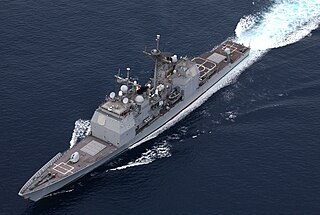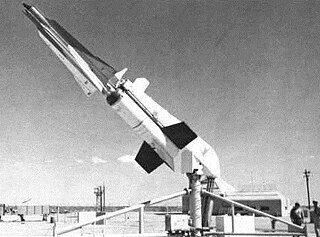
The RUR-5 ASROC is an all-weather, all sea-conditions anti-submarine missile system. Developed by the United States Navy in the 1950s, it was deployed in the 1960s, updated in the 1990s, and eventually installed on over 200 USN surface ships, specifically cruisers, destroyers, and frigates. The ASROC has been deployed on scores of warships of many other navies, including Canada, Germany, Italy, Japan, the Republic of China, Greece, Pakistan and others.

A cruiser is a type of warship. Modern cruisers are generally the largest ships in a fleet after aircraft carriers and amphibious assault ships, and can usually perform several roles.

The Aegis Combat System is an American integrated naval weapons system, which uses computers and radars to track and guide weapons to destroy enemy targets. It was developed by the Missile and Surface Radar Division of RCA, and it is now produced by Lockheed Martin.

The County class was a class of British guided missile destroyers, the first such warships built by the Royal Navy. Designed specifically around the Seaslug anti-aircraft missile system, the primary role of these ships was area air defence around the aircraft carrier task force in the nuclear-war environment.

The Convair RIM-2 Terrier was a two-stage medium-range naval surface-to-air missile (SAM), among the earliest SAMs to equip United States Navy ships. It underwent significant upgrades while in service, starting with beam-riding guidance with a 10-nautical-mile (19 km) range at a speed of Mach 1.8 and ending as a semi-active radar homing (SARH) system with a range of 40 nmi (74 km) at speeds as high as Mach 3. It was replaced in service by the RIM-67 Standard ER (SM-1ER).

The United States Navy reclassified many of its surface vessels in 1975, changing terminology and hull classification symbols for cruisers, frigates, and ocean escorts.

The AN/SPG-51 is an American tracking / illumination fire-control radar for RIM-24 Tartar and RIM-66 Standard missiles. It is used for target tracking and Surface-to-air missile guidance as part of the Mk. 73 gun and missile director system, which is part of the Tartar Guided Missile Fire Control System.

The Mark 13 guided missile launching system (GMLS) is a single-arm missile launcher designed for use on frigates and other military vessels. Because of its distinctive single-armed design, the Mark 13 is often referred to as the "one-armed bandit".

Bendix RIM-8 Talos was a long-range naval surface-to-air missile (SAM), among the earliest SAMs to equip United States Navy ships. The Talos used radar beam riding for guidance to the vicinity of its target, and semi-active radar homing (SARH) for terminal guidance. The four antennas surrounding the nose were SARH receivers, which functioned as a continuous wave interferometer. A solid rocket booster provided thrust for launch and a Bendix ramjet powered its flight to the target, with the warhead serving as the ramjet's compressor.

The Tartar Guided Missile Fire Control System is an air defense system developed by the United States Navy to defend warships from air attack. Since its introduction the system has been improved and sold to several United States allies.

The 5" /54 caliber lightweight gun is a U.S. naval artillery gun mount consisting of a 5 in (127 mm) L54 Mark 19 gun on the Mark 45 mount. It was designed and built by United Defense, a company later acquired by BAE Systems Land & Armaments, which continued manufacture.

New Threat Upgrade (NTU) was a United States Navy program to improve and modernize the capability of existing cruisers and destroyers equipped with Terrier and Tartar anti-aircraft systems, keeping them in service longer.

The Belknap-class cruiser was a class of single-ended guided-missile cruisers built for the United States Navy during the 1960s. They were originally designated as DLG frigates, but in the 1975 fleet realignment, they were reclassified as guided missile cruisers (CG).

Operation Bumblebee was a US Navy effort to develop surface-to-air missiles (SAMs) to provide a mid-range layer of anti-aircraft defense between anti-aircraft guns in the short range and fighter aircraft operating at long range. A major reason for the Bumblebee efforts was the need to engage bombers before they could launch standoff anti-shipping weapons, as these aircraft might never enter the range of the shipboard guns.

The Albany-class guided-missile cruisers were converted Baltimore and Oregon City-class heavy cruisers of the United States Navy. All original superstructure and weapons were removed and replaced under project SCB 172. The converted ships had new very high superstructures and relied heavily on aluminium to save weight.

The RIM-66 Standard MR (SM-1MR/SM-2MR) is a medium-range surface-to-air missile (SAM), with a secondary role as an anti-ship missile, developed for the United States Navy (USN). A member of the Standard Missile family of weapons, the SM-1 was developed as a replacement for the RIM-2 Terrier and RIM-24 Tartar that were deployed in the 1950s on a variety of USN ships. The RIM-67 Standard (SM-1ER/SM-2ER) is an extended range version of this missile with a solid rocket booster stage.

The RIM-67 Standard ER (SM-1ER/SM-2ER) is an extended range surface-to-air missile (SAM) with a secondary anti-ship capability, originally developed for the United States Navy (USN). The RIM-67 was developed as a replacement for the RIM-8 Talos, a 1950s system deployed on a variety of USN ships, and eventually replaced the RIM-2 Terrier as well, since it was of a similar size and fitted existing Terrier launchers and magazines. The RIM-66 Standard MR was essentially the same missile without the booster stage, designed to replace the RIM-24 Tartar. The RIM-66/67 series thus became the US Navy's universal SAM system, hence the designation "Standard Missile".

Typhon was a missile system developed by the United States Navy in the late 1950s, intended to serve as an integrated air-defense system for Navy fleets. Consisting of the SAM-N-8 Typhon LR, later designated RIM-50A, and the SAM-N-9 Typhon MR, later RIM-55A, paired with the AN/SPG-59 radar system, the cost of the Typhon system led to it being cancelled in favor of the Standard Missile program.

The Mark 41 Vertical Launching System is a shipborne missile canister launching system which provides a rapid-fire launch capability against hostile threats. The Vertical Launch System (VLS) concept was derived from work on the Aegis Combat System.

















